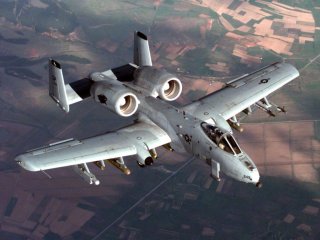The Military Is Begging: Will Congress Ever Retire the A-10 Warthog?
A-10 Thunderbolt II, affectionately known as the Warthog, has been in service since the late 1970s and served as a close air support aircraft in conflicts such as the Gulf War, Operation Enduring Freedom, Operation Iraqi Freedom and Operation Allied Force in Kosovo, among others.
Here's What You Need To Remember: The A-10 carries a full complement of weapons, including GPS-guided Joint Direct Attack Munitions. Its arsenal includes GBU 38s, GBU 31s, GBU 54s, Mk 82s, Mk 84s, AGM-65s, AIM-9 Sidewinder missiles and rockets along with illumination flares, jammer pods and other protective countermeasures. The aircraft can carry 16,000 pounds of mixed ordnance—eight can fly under the wings and three under the fuselage.
Its ability to withstand small arms fire has earned it the distinction as a “flying tank,” complete with a hull built of titanium armor. Known for being able to loiter in the sky above-ground targets, the A-10 has long been cherished and revered by ground troops under enemy fire who appreciate its 30-millimeter cannon firing upon their enemies.
A-10 Thunderbolt II, affectionately known as the Warthog, has been in service since the late 1970s and served as a close air support aircraft in conflicts such as the Gulf War, Operation Enduring Freedom, Operation Iraqi Freedom and Operation Allied Force in Kosovo, among others.
If the aircraft loses all of its electronics including its digital displays and targeting systems, the pilot of an A-10 can still fly, drop general-purpose bombs and shoot the 30-millimeter cannon. Unlike other aircraft built for speed, maneuverability, air-to-air dogfighting and air-to-air weapons, the A-10 is specifically engineered around its gun, a 30-millimeter GAU-8/A cannon aligned directly beneath the fuselage. Armed with 1,150 rounds, the 30-millimeter cannon is able to fire seventy rounds a second.
The gun alignment is straight along the fuselage line without an upward “cant” like many other aircraft have. The windows in the A-10 are wider, giving pilots a larger field of view with which to see and attack targets. The engines of the A-10 are mounted high so that the aircraft can land in austere environments such as rugged, dirty or sandy terrain. The rugged engines on the A-10 are General Electric TF34-GE-100 turbofans. There have been many instances where A-10 engines were shot up and the pilots did not know until returning from a mission, an A-10 pilot told The National Interest.
These aerodynamic configurations and engine technology allow the A-10 to fly slower and lower, in closer proximity to ground forces and enemy targets. The A-10 fires weapons from as close as fifty meters away at times, and uses the same targeting pod as the F-15E and F-16.
The A-10 carries a full complement of weapons, including GPS-guided Joint Direct Attack Munitions. Its arsenal includes GBU 38s, GBU 31s, GBU 54s, Mk 82s, Mk 84s, AGM-65s, AIM-9 Sidewinder missiles and rockets along with illumination flares, jammer pods and other protective countermeasures. The aircraft can carry 16,000 pounds of mixed ordnance—eight can fly under the wings and three under the fuselage.
By virtue of being able to fly at slower speeds of 300 knots, the A-10 can fly beneath the clouds at altitudes of 100 feet. This gives pilots an ability to see enemy targets with the naked eye, and then drop bombs, fire rockets or shoot with the 30-millimeter cannon in close proximity to friendly forces.
The A-10 uses both “Lightning” and “Sniper” pods engineered with infrared and electro-optical sensors to find targets for the pilot.
Pilots flying attack missions in the Warthog communicate with other aircraft and ground forces using radios and a data-link known as LINK 16. Pilots can also text messages with other aircraft and across platforms.
The cockpit is engineered with what is called the CASS cockpit, for Common Avionics Architecture System, which includes moving digital map displays and various screens showing pertinent information such as altitude, elevation, surrounding terrain and target data.
Kris Osborn is the defense editor for the National Interest. Osborn previously served at the Pentagon as a Highly Qualified Expert with the Office of the Assistant Secretary of the Army—Acquisition, Logistics & Technology. Osborn has also worked as an anchor and on-air military specialist at national TV networks. He has appeared as a guest military expert on Fox News, MSNBC, The Military Channel, and The History Channel. He also has a Master's Degree in Comparative Literature from Columbia University. This article first appeared earlier this year.
Image: Wikipedia.

